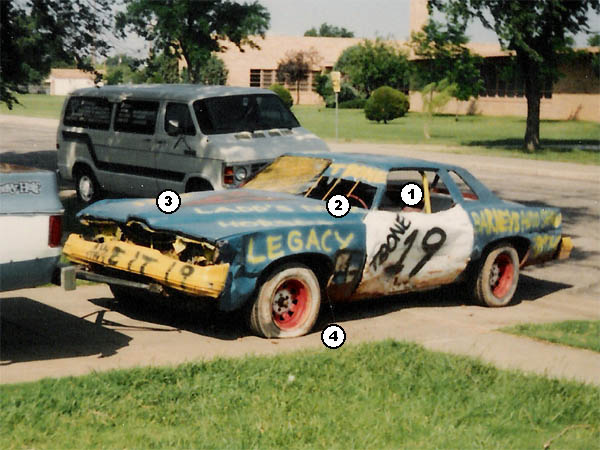August 12, 2005 - 5:28 pm
Back in the summer of 1995 I had the opportunity to fulfill one of my life goals. That goal was to finish in the top five in an automobile race.
It all started at the Tri-State Fair in Amarillo. My friend Galyn and I watched the demolition derby at the fair. It was great fun and seemed like something I would enjoy doing. My uncle, Barney, was (and is) the owner of a very successful auto service shop and sponsored one of his mechanics at the dirt track races. I knew that he would know something about getting into the derby.
When I asked Barney about it, he asked me if I’d ever raced a car in the dirt. “No,” I said, “but what does that have to do with the derby? It’s not a race.”
 He recommended that I do some dirt track racing so I could get used to driving a big, heavy car in the dirt. It’s very different than driving on the street. He told me that he still had last year’s thunder-bomber sitting behind the shop and if I could get it running he would sponsor me to race it. What he didn’t tell me was that the last time the car had been driven, Robbie (his racing mechanic) had overheated it and the engine caught on fire. I’ve never confirmed it with him, but I’m fairly sure that he didn’t think I could get the car to start.
He recommended that I do some dirt track racing so I could get used to driving a big, heavy car in the dirt. It’s very different than driving on the street. He told me that he still had last year’s thunder-bomber sitting behind the shop and if I could get it running he would sponsor me to race it. What he didn’t tell me was that the last time the car had been driven, Robbie (his racing mechanic) had overheated it and the engine caught on fire. I’ve never confirmed it with him, but I’m fairly sure that he didn’t think I could get the car to start.
I put a new battery and new spark plug wires in it and the car started right up. Barney and Robbie were blown away. I’m telling you there was something very special about that car. Imagine Steven King’s Christine, the homicidal car that seemed to be demon possessed. Well, this car was Christine’s opposite and must have possessed by angels.
Now, let me explain a little about thunder-bombers. A thunder-bomber is the cheapest racing class at a dirt track. In my case, it was a 1976 Pontiac Grand Prix 2 door, with a 350 V-8 engine, that had been in a minor wreck before becoming a bomber. The rules for thunder-bombers are simple: weld the doors shut, strip off the chrome and glass, and paint a number on the door. That’s it. No fancy engine, no racing tech, just a tough old American car and the dirt. You can see bomber class cars racing at a dirt track near you, but most likely, they have more safety rules than the old Dirt Track Speedway in Amarillo had back then.
My car was safer than most. Since Robbie had run it in a street stock endurance race (thus catching it on fire), it had been upgraded to meet the street stock rules. It had a roll bar, the interior had been stripped down to the metal, and the windshield had been removed. It had a racing seat in it, but that was Robbie’s and he removed it to use in his street stock car. I was able to get the stock bench seat back in (through the back window) along with the standard three-point seat belts. It was also the only car on the track that had full exhaust. Barney had threatened me with bodily harm if I cut the exhaust off (which was the normal practice for the sake of gaining some horsepower). He said that he had personally installed that exhaust system just before the car was wrecked and it was “brand new”. Because my car was properly muffled, it became known as “The Mouse”. When all the bombers were roaring around the track, mine, in comparison, seemed quiet as a mouse.

Here you see the Mouse after my first race. There are a few things to notice (numbered).
- Every racer has to have a cool name. Mine was “T-Bone”.
- The car was in pretty good shape considering it had already suffered though one season of racing. There were only minor dents in the fenders and doors.
- Likewise, the hood was nice and straight with no real damage.
- At the beginning of every race, the tires were fully inflated with the sidewalls painted. The paint was not only for decoration. It also gave me an idea of how hard I was “rolling” the tires, as in, forcing them onto the sidewalls during cornering. Rolling onto the sidewalls causes the air to come out of the tires and can cause the tire to separate from the rim. That’s a bad thing.
The rules at Dirt Track Speedway were pretty bizarre, based more on tradition than safety. Each car was required to start the race with hubcaps on both right side wheels. I think this was meant to discourage the use of heavy duty racing wheels, but the real result was that folks (like me) used a rubber hammer to get the hubcaps to stay on the racing rims long enough to start the race. There were no rules for the interior other than seatbelts were required. Almost all the other bombers on the track had stock interiors with no roll bars or any other safety equipment. Also, bombers were allowed to carry a co-driver, the equivalent of a spotter, to keep the driver apprised of the situation behind and beside the car. Some cars still had the rear view mirror attached to the windshield, but none of them had side mirrors. Mine had no mirrors at all. Good ol’ Galyn acted as my mirrors (and did a great job of it, by the way).

- Galyn had a racing name too. It was “The Baron”.
- Notice the nice, straight passenger side sheet metal.
- Yes, I know I misspelled the tail message, “Dust 4 Diner” (instead of “Dinner”). I ran out of room and doubted that the other drivers would know it was wrong.
- Notice how much paint scrubbed off of the tire sidewalls due to “rolling”.
There is a good reason that race cars do not have cushy interiors, with carpeted floors, vinyl dashes and cloth seats. Carpet and vinyl can catch on fire in the extreme conditions of a race. During one of my races a car was completely engulfed in flames and burned to the ground, so to speak. The driver and co-driver escaped unharmed, but the thick smoke blowing across the track made the turn four a real nail-biter.

- Glare is a real problem during the race. The grand stand lights shine right in your eyes as you round turn four and with your goggles covered in dust, mud, rubber, and who knows what else, it was more important to block out the lights than it was to see the flag stand (that’s what co-drivers are for).
- With the windows and door panels removed, the window sills were nothing but sharp metal edges eager to rip your pants (if not the flesh beneath) when you slid in and out of the car. The doors must be welded or chained shut according to the rules. My car had about three rolls of duct tape covering the sills, more as the season went on.
- In our first race, Galyn had no front protection, just a big open space where the windshield had been. It only took one large clod of dirt in the jaw to convince us that he needed more. I added this expanded steal the next week. He lost some forward visibility, but his job was to look backward anyway.
Remember me saying that the Mouse seemed to have its own, in-house angel? Consider this: With the poor safety rules and dangerous race conditions at our track, the average life-span of a thunder bomber was about one race. Very few cars completed a whole season. Most did not complete a single race before coming apart. The Mouse soldiered on for two whole seasons (mine being the second). When I completed my last race of the season, the Mouse, tough as it was, was ready for retirement.

- The nice shiny wheel and tire were put on after the race to replace the mangled mess that I had raced on. I lost the tire after about 30 laps of the 54 lap race, but you don’t get pit-stops in thunder bombers, so I finished on three.
- Notice the severely mangled front fender and door.
I still feel indebted to Barney for giving me the opportunity to race. It was a once in a life-time experience. I finished the season with one third place finish and a win. I won the last race I raced in. It was the most difficult of all for several reasons. Galyn was not able to come that night, so I was without a co-driver. (Turns out this was one more case of the angels looking out for us, because I took my hardest hit of the season on the passenger door. Had Galyn been leaning on that door, he would certainly have been injured.) It was the longest race of the season, 54 laps. The lap count was decided by how many cars entered the race. 54 big, ol’ boats screaming around a 1/3rd mile track. It was a huge mess. Of the 54 cars that started the race, less than 10 finished. Oh, and by the way, we had no yellow flags back then. If there were 15 cars piled up on the back straight, you just drove around them. And if your car was disabled on the track, you just had to sit there until the race was over. We used to call it, “the best seat in the house.”

- Remember that nice straight hood? Well, not for long. This happened in my third race, when a driver spun out in front of me and we hit each other head on. It bent the frame beyond repair, but nobody really cares if you have bad alignment on a thunder bomber.
- Notice how much paint was scrubbed off the side walls. It was a miracle this tire held air throughout the race. I was nearly driving on the rim through the corners.

- Here you can see the frame is completely collapsed behind the bumper. We straightened the bumper back out by chaining it to a utility pole, throwing the car in reverse and flooring it. Voila! Good as new.
- Notice how far in the passenger door was smashed in that last race. Once again, thank God Galyn wasn’t leaning on that door when it happened.



